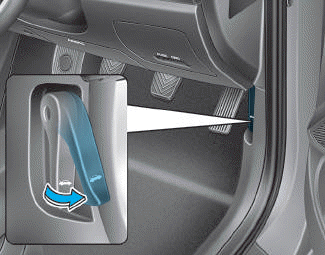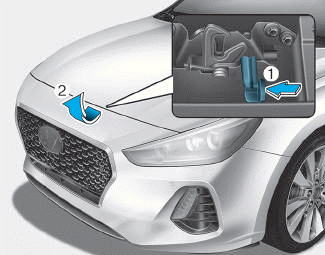Hyundai i-30: Trailer towing / Driving with a trailer
Towing a trailer requires a certain amount of experience. Before setting out for the open road, you must get to know your trailer. Acquaint yourself with the feel of handling and braking with the added weight of the trailer. And always keep in mind that the vehicle you are driving is now longer and not nearly as responsive as your vehicle is by itself.
Before you start, check the trailer towbar and platform, safety chains, electrical connector(s), lights, tyres and brakes.
During your trip, occasionally check to be sure that the load is secure, and that the lights and trailer brakes are still working.
Distance
Stay at least twice as far behind the vehicle ahead as you would when driving your vehicle without a trailer. This can help you avoid situations that require heavy braking and sudden turns.
Passing
You will need more passing distance up ahead when you’re towing a trailer. And, because of the increased vehicle length, you’ll need to go much farther beyond the passed vehicle before you can return to your lane.
Backing up
Hold the bottom of the steering wheel with one hand. Then, to move the trailer to the left, move your hand to the left. To move the trailer to the right, move your hand to the right. Always back up slowly and, if possible, have someone guide you.
Making turns
When you’re turning with a trailer, make wider turns than normal. Do this so your trailer won’t strike soft shoulders, kurbs, road signs, trees, or other objects. Avoid jerky or sudden manoeuvres. Signal well in advance.
Turn signals
When you tow a trailer, your vehicle has to have a different turn signal flasher and extra wiring. The green arrows on your instrument panel will flash whenever you signal a turn or lane change. Properly connected, the trailer lights will also flash to alert other drivers you’re about to turn, change lanes, or stop.
When towing a trailer, the green arrows on your instrument panel will flash for turns even if the bulbs on the trailer are burned out. Thus, you may think drivers behind you are seeing your signals when, in fact, they are not. It’s important to check occasionally to be sure the trailer bulbs are still working.You must also check the lights every time you disconnect and then reconnect the wires.
WARNING
Do not connect a trailer lighting system directly to your vehicle’s lighting system. Use an approved trailer wiring harness. Failure to do so could result in damage to the vehicle electrical system and/or personal injury. Consult a HYUNDAI authorised repairer for assistance.
Driving on hills
Reduce speed and shift to a lower gear before you start down a long or steep downgrade. If you don’t shift down, you might have to use your brakes so much that they would get overheated and may not operate efficiently.
On a long uphill grade, shift down and reduce your speed to around 45 mph (70 km/h) to reduce the possibility of engine and transmission overheating.
If your trailer weighs more than the maximum trailer weight without trailer brakes and you have an automatic transmission/dual clutch transmission, you should drive in D (Drive) when towing a trailer.
Operating your vehicle in D (Drive) when towing a trailer will minimise heat build-up and extend the life of your transmission.
NOTICE
To prevent engine and/or transmission overheating:
- When towing a trailer on steep grades (in excess of 6%) pay close attention to the engine coolant temperature gauge to ensure the engine does not overheat. If the needle of the coolant temperature gauge moves towards "130", pull over and stop as soon as it is safe to do so, and allow the engine to idle until it cools down.You may proceed once the engine has cooled sufficiently.
- If you tow a trailer with the maximum gross vehicle weight and maximum trailer weight, it can cause the engine or transmission to overheat. When driving in such conditions, allow the engine to idle until it cools down.You may proceed once the engine or transmission has cooled sufficiently.
- When towing a trailer, your vehicle speed may be much slower than the general flow of traffic, especially when climbing an uphill grade. Use the right hand lane when towing a trailer on an uphill grade. Choose your vehicle speed according to the maximum posted speed limit for vehicles with trailers, the steepness of the grade, and your trailer weight.
- Vehicles equipped with a dual clutch transmission when towing a trailer on steep grades, need to be aware that the clutch in the transmission could overheat. When the clutch is overheated, the safe protection mode engages. If the safe protection mode engages, the gear position indicator on the cluster blinks with a chime sound.
At this time, a warning message will appear on the LCD display and driving may not be smooth. If you ignore this warning, the driving condition may become worse.
To return to normal driving conditions, stop the vehicle on a flat road and apply the foot brake for a few minutes before driving off.
Parking on hills
Generally, if you have a trailer attached to your vehicle, you should not park your vehicle on a hill.
However, if you ever have to park your trailer on a hill, here's how to do it:
1. Pull the vehicle into the parking space.
Turn the steering wheel in the direction of the kerb (left if headed down hill, right if headed up hill).
2. Shift the vehicle to P (Park, for automatic transmission/dual clutch transmission vehicle) or neutral (for manual transmission vehicle).
3. Set the parking brake and shut off the vehicle.
4. Place wheel chocks under the trailer wheels on the down hill side of the wheels.
5. Start the vehicle, hold the brakes, shift to neutral, release the parking brake and slowly release the brakes until the trailer chocks absorb the load.
6. Reapply the brakes and parking brakes.
7. Move the shift lever to P (Park, for automatic transmission/dual clutch transmission vehicle) or 1st gear (for manual transmission vehicle) when the vehicle is parked on a uphill grade and in R (Reverse) on a downhill.
8. Shut off the vehicle and release the vehicle brakes but leave the parking brake set.
WARNING
To prevent serious or fatal injury:
- Do not get out of the vehicle without the parking brake firmly set. If you have left the engine running, the vehicle can move suddenly. You and others could be seriously or fatally injured.
- Do not apply the accelerator pedal to hold the vehicle on an uphill.
Ready to leave after parking on a hill
1. With the shift lever in P (Park, for automatic transmission/dual clutch transmission vehicle) or neutral (for manual transmission vehicle), apply your brakes and hold the brake pedal down whilst you:
- Start your engine;
- Shift into gear; and
- Release the parking brake.
2. Slowly remove your foot from the brake pedal.
3. Drive slowly until the trailer is clear of the chocks.
4. Stop and have someone pick up and store the chocks.
 Trailer towing equipment
Trailer towing equipment
Towbars
Information
The mounting hole for towbars are
located on both sides of the underbody
behind the rear tyres.
It's important to have the correct towbar
equipment...
 Maintenance when towing a
trailer
Maintenance when towing a
trailer
Your vehicle will need service more
often when you regularly pull a trailer.
Important items to pay particular
attention to include engine oil, automatic
transmission fluid, axle lubricant
and cooling system fluid...
Other information:
Hyundai i30 (PD) 2018-2025 Owner's Manual: Front seat head restraints
The driver’s and front passenger’s seats are equipped with adjustable head restraints for the passengers safety and comfort. Adjusting the height up and down To raise the head restraint: 1. Pull it up to the desired position (1). To lower the head restraint: 1...
Hyundai i30 (PD) 2018-2025 Owner's Manual: Air bag inflation conditions
Front air bags Front air bags are designed to inflate in a frontal collision depending on the severity, speed or angles of impact of the front collision. Side and curtain air bags Side and curtain air bags are designed to inflate when an impact is detected by side collision sensors depending on the severity, speed or angles of impact resulting from a side impact collision...
Categories
- Manuals Home
- 3rd Generation i30 Owners Manual
- 3rd Generation i30 Service Manual
- Jump starting procedure
- To activate the ISG system
- LKA system operation
- New on site
- Most important about car
Bonnet
Opening the bonnet

1. Park the vehicle and set the parking brake.
2. Pull the release lever to unlatch the bonnet. The bonnet should pop open slightly.

